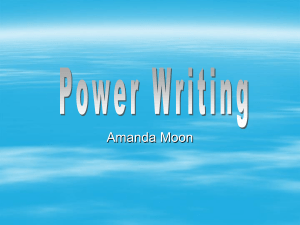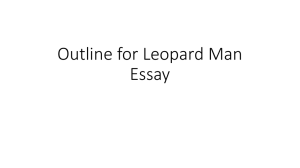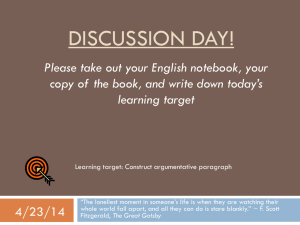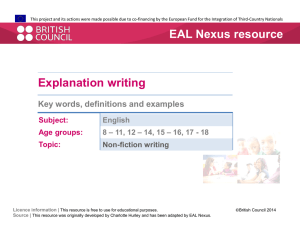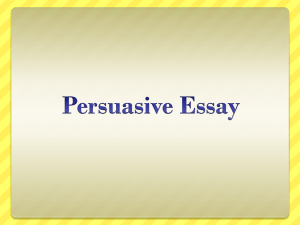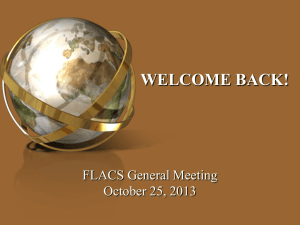Paragraph Transitions
advertisement
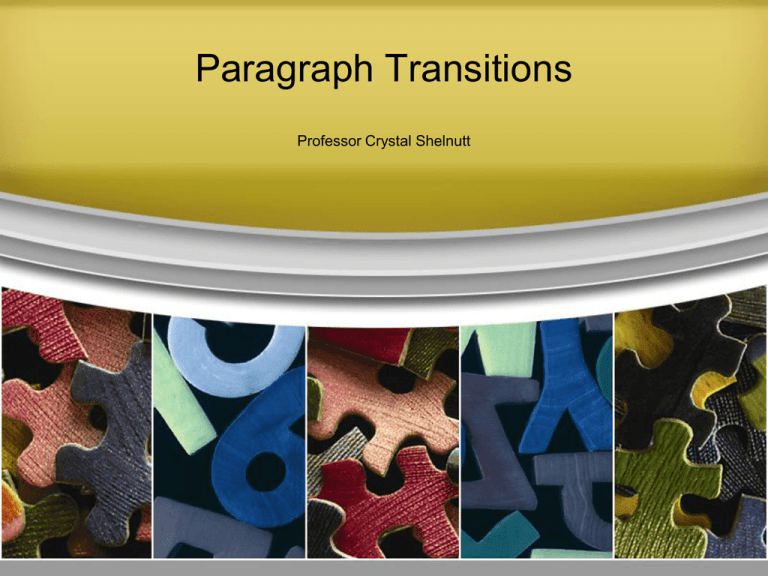
Paragraph Transitions Professor Crystal Shelnutt Types of Transitions 1) Standard devices 2) Paragraph hooks 3) Combinations of 1 & 2 Standard Devices • Simple and obvious • Specific words and phrases • AWR : Tab 10, 52d (p. 457?) Standard Devices Oversimplified Examples: • Puppies are a nuisance. • They are wonderful. • True, puppies are a nuisance. • Nevertheless, they are wonderful. Standard Devices • The project had value. • It wasted time. • Admittedly, the project had value. • But it was wasted time. Standard Devices • He was a brilliant actor. • He often performed miserably. • He was, to be sure, a brilliant actor. • Yet he often performed miserably. Standard Devices • Note on “however”: • The best position for however is nearly always inside a sentence, between commas: – Good study habits, however, cannot be established overnight. Paragraph “Hooks” • Standard words and phrases are good • They cannot, however, handle the whole transitional load: they become overused • “Hook” words from the previous paragraph into the next • Either from the last sentence or even deeper into the previous paragraph Paragraph “Hook” ¶ Mark Twain is established in the minds of most Americans as a kindly humorist, a gentle and delight “funny man.” No doubt his photographs have helped promote this image. Everybody is familiar with the Twain face. He looks like every child’s ideal grandfather, a dear old white-thatched gentleman who embodies the very spirit of loving-kindness. Paragraph “Hook” • (Standard transition) ¶ But Twain wrote some of the most savage satire ever produced in America . . . • Abrupt leap from one idea to the next • Mechanical Paragraph “Hook” ¶ . . . a dear old white-thatched gentleman who embodies the very spirit of loving-kindness. ¶ The loving-kindness begins to look a little doubtful in view of some of his writing. For Twain wrote some of the most savage satire . . . • The last word of the previous paragraph “hooks” into the first sentence of the next paragraph and provides a point of departure for next idea Deeper Paragraph “Hook” ¶ . . . a dear old white-thatched gentleman who embodies the very spirit of loving-kindness. ¶ This dear old white-thatched gentleman happens to be the author of some of the most savage satire . . . • Generally, the last sentence is best place to find your “hook” to get to your next paragraph Still deeper: The Multiple Hook ¶. . . photographs have helped promote this image. Everybody is familiar with the Twain face . . . ¶ To accept such an image is to betray greater familiarity with the photographs than with the writing. For Twain wrote some of the most savage satire . . . • Here you have the “double-hook” • The greater the distance, the more likely your need for multiple words to make the connections clear A Note on the “Hook” • Don’t insult your reader by making the connection too clear • That is, don’t repeat huge sections or whole sentences from the preceding paragraph. • One or two words will do the job. The Idea “Hook” • So far, examples are simple words or phrases • Another variation of the paragraph “hook” is the idea hook • Principle is the same: hooking into the preceding paragraph • Instead of repeating an exact word or phrase, however, you refer to the idea just expressed • Compress that idea into a single phrase The Idea “Hook” (Recall our paragraph: Twain as kind, dear, loving) ¶ Such a view of Twain would probably have been a source of high amusement to the author himself. For Twain wrote some of the most savage satire . . . • Or ¶ Any resemblance between this popular portrait and the man who reveals himself in his writing is purely imaginary. For Twain wrote . . . The Combination • Natural, matter of course • Use your sense of what the reader requires for clarity • Use with your own sense of rhythm and sound in writing The Combination ¶ The loving-kindness begins to look a little doubtful, however, in view of . . . ¶ Yet this dear old white-thatched gentleman . . . ¶ But to accept such an image . . . ¶ Such a view of Twain, however, would probably . . . Some Transitional Phrases • • • • • • • • • • Admittedly And Assuredly But Certainly Clearly, then Consequently Even so Furthermore Granted Some Transitional Phrases • • • • • • • • • • In addition In fact Indeed It is true that Moreover Nevertheless No doubt Nobody denies Obviously Of course Some Transitional Phrases • • • • • • • • • • On the other hand Still The fact remains Therefore Thus To be sure True Undoubtedly Unquestionably Yet Work Cited • Payne, Lucile Vaughan. The Lively Art of Writing. New York: Penguin, 1965. Print.
